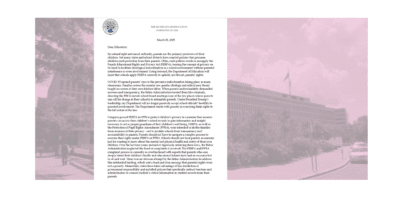
The U.S. Department of Education (DOE) announced on Tuesday six new interagency agreements (IAAs) with four federal agencies “to break up the federal education bureaucracy, ensure efficient delivery of funded programs, activities, and move closer to fulfilling the President’s promise to return education to the states.”
This announcement marks the latest effort by the Trump administration to overhaul the DOE, which has historically managed federal education grant programs and provided states support and accountability with federal compliance since its creation by Congress in 1979. While only Congress has the power to dismantle a federal agency, the DOE says “IAAs are a tool commonly used by government agencies to share services, collaborate, and ensure efficient service delivery.”
![]() Sign up for the EdDaily to start each weekday with the top education news.
Sign up for the EdDaily to start each weekday with the top education news.
“Cutting through layers of red tape in Washington is one essential piece of our final mission,” U.S. Secretary of Education Linda McMahon said in a press release. “As we partner with these agencies to improve federal programs, we will continue to gather best practices in each state through our 50-state tour, empower local leaders in K-12 education, restore excellence to higher education, and work with Congress to codify these reforms. Together, we will refocus education on students, families, and schools — ensuring federal taxpayer spending is supporting a world-class education system.”
The new IAAs are with the departments of Labor (DOL), Interior (DOI), Health and Human Services (HHS), and State, according to the press release.
The six partnerships involve oversight of programs related to elementary and secondary education, postsecondary education, Indian education, foreign medical accreditation, child care access, and international education and foreign language studies. The release says that the DOE will offer “proper oversight” of the agencies taking on new education administration roles, but does not lay out what such oversight will look like specifically.
Since the announcement, reactions to the new partnerships have been mixed, and largely divided by political affiliation.
Several higher education leaders have said they care most about making sure students and institutions still receive grant dollars, according to a report from Inside Higher Ed, not necessarily what agency such grants are housed under. Those in favor of the move say the partnerships will ultimately move more control to states and local school districts.
However, some education leaders and advocacy groups said they are worried about the capacity of agencies to administer the programs, the cost of the partnerships, and potentially rough transitions.
For its part, the DOE said “states and grantees should not expect to experience programmatic disruptions due to the partnership(s)” and that “announcements on any additional process-related transitions will be made available through known channels of communication.”
Below, you can find a look at the impacted programs under each IAA.
Related reads



K-12 education
According to the press release, the DOL will “take on a greater role in administering federal K-12 programs, ensuring these programs are better aligned with workforce and college programs to set students up for success at every part of their education journey.”
“With proper oversight by (DOE), DOL will manage competitions, provide technical assistance, and integrate (DOE’s) programs with the suite of employment and training programs DOL already administers,” the release says.
A majority of DOE funding for K-12 schools will now be administered by the DOL, according to a report from EdWeek — more than $20 billion a year.
Here is a look at the elementary and secondary education programs included under the partnership:
- Title I, Part A: Improving Basic Programs operated by Local Educational Agencies (LEA)
- Title I, Part B: Improving Academic Achievement of the Disadvantaged — State
Assessment Grants - Title I, Part C: Education of Migratory Children
- Title I, Part D: Prevention and Intervention Programs for children and youth who are neglected, delinquent, or at-risk
- Title II, Part A: Supporting Effective Instruction state grants
- Title III, Part A: English Language Acquisition state grants
- Title IV, Part A, Student Support and Academic Enrichment (SSAE)
- Title IV, Part B 21st Century Community Learning Centers
- Title V Small, Rural School Achievement and Rural and Low-Income School programs
- Impact aid
- Education for Homeless Children and Youths
- Republic of Palau grant
- Consolidated Grants to the Insular Areas
“The Labor Department is committed to working with the Department of Education to ensure our K-12 and postsecondary education programs prepare students for today and tomorrow’s workforce demands,” Secretary of Labor Lori Chavez-DeRemer said in the release. “… Secretary McMahon and I will continue advancing President Trump’s vision to deliver effective, streamlined resources, so every student has a clear pathway from education to opportunity.”
The partnership also includes a number of grant programs:
- Comprehensive literacy state development
- Innovative approaches to literacy
- Supporting effective educator development
- Charter schools program
- Assistance for arts education
- Washington D.C. Scholarships for Opportunity and Results (SOAR) Act
- Ready to Learn programming
- Teacher and school leader incentive
- Teacher Quality Partnership grant
- American history and civics
- Statewide Family Engagement Centers
- Promise neighborhoods
- Magnet schools assistance program
- Full-service community schools
You can read a fact sheet on the elementary and secondary education partnership on the DOE’s website.
Postsecondary education
DOL will also take on a greater role in administering most postsecondary education grant programs authorized under the Higher Education Act, per the release.
The partnership is meant to better coordinate postsecondary education and workforce development programs, the release says, and “the backdrop for this agreement is our nation’s annual labor shortage of over 700,000 skilled jobs.”
According to the DOE press release: “These agreements follow a successful workforce development partnership signed with DOL earlier this year, which has created an integrated federal education and workforce system and reduced the need for states to consult multiple federal agencies to effectively manage their programs.”
Here is a look at the impacted postsecondary programs:
- TRIO
- Upward Bound
- Upward Bound Math and Science
- Veterans Upward Bound
- Talent Search
- McNair Scholars Program
- Student Support Services Program
- Educational Opportunity Centers
- Training Program for Federal TRIO Programs
- Gaining Early Awareness and Readiness for Undergraduate Programs (GEAR UP)
- Graduate Assistance in Areas of National Need (GAANN)
- Augustus F. Hawkins Center of Excellence
- Title III, Part A: Strengthening Institutions program
- Title III, Part B: Strengthening Historically Black Colleges and Universities program
- Master’s Degree Programs at Historically Black Colleges and Universities program
- Strengthening Historically Black Graduate Institutions (HBGI)
- Howard University
- Higher Education Emergency Relief Fund
- Transition and Postsecondary Programs for Students with Intellectual Disabilities (TPSID)
- Transition Programs for Students with Intellectual Disabilities Coordinating Center (TPSID-CC)
- Fund for the Improvement of Postsecondary Education (FIPSE)
- Higher Education Congressionally Funded Community Projects program
The postsecondary agreement also includes two elementary and secondary education programs: the High School Equivalency Program (HEP) and the College Assistance Migrant Program (CAMP).
“Both of these programs directly connect to postsecondary opportunities, which make them a natural fit for this partnership,” the DOE postsecondary fact sheet says.
Child care access
According to the release, DOE and HHS are establishing a partnership for the Child Care Access Means Parents in School (CCAMPIS) program to “improve on-campus child care support for parents enrolled in college.”
HHS will manage existing competitions, provide technical assistance, and integrate DOE’s CCAMPIS program, the release says.
“The Trump Administration is streamlining unnecessary bureaucracy and cutting red tape to allow us to serve more student-parents across college campuses,” said Alex J. Adams, assistant secretary for the Administration for Children and Families. “Our partnership with the Department of Education will ensure families have access to childcare options that meet their needs and can accelerate their educational and economic success.”
View the partnership fact sheet for the child care partnership here.
Indian education
DOE and DOI are establishing the Indian Education Partnership to “improve Native American education in the United States,” the release says.
DOI will take on a greater role in administering Indian Education programs relating to elementary and secondary education, higher education, career and technical education, and vocational rehabilitation, solidifying the agency as the key point of contact for Tribes and Native students.
Here is a look at the impacted programs.
Elementary and secondary education:
- Indian Education Grants to LEAs
- Special programs for Indian children — Indian Education Professional Development Grant Program (PD)
- Special programs for Indian children — Demonstration grants (DEMO)
- State Tribal Education Partnership Program (STEP)
- Native American and Alaska Native Language Program (NALED)
- Native American Language Resource Center Program (NALRC)
- Alaska Native Education Program (ANEP)
- Native Hawaiian Education Program (NHEP) and the Native Hawaiian Education Council
- Native American and Alaska Native Children in School (NAM) program
Postsecondary:
- American Indian Tribally Controlled Colleges and Universities authorized under Title III, Part A of the Higher Education Act, Section 316 and Part F of the Higher Education Act, Section 371
- Indian Education-related Research and Development Infrastructure Grant program components authorized under Title VII, Part B of the Higher Education Act
Office of Career, Technical, and Adult Education:
- Tribally Controlled Postsecondary Career and Technical Institutions program
Office of Special Education and Rehabilitative Services:
- American Indian Vocational Rehabilitation Services program
- Continued support for IDEA Part D funding for Tribally controlled colleges and universities (TCCUs)
View the partnership fact sheet for Indian education here.
International education and foreign language studies
The DOE and Department of State are establishing the International Education and Foreign Language Studies Partnership to “improve efficiencies for programs administered under the Fulbright-Hays grant.”
According to the release, the State department already administers the Fulbright Program and is “best positioned to tailor foreign education programs with the national security and foreign policy priorities of the United States.”
Read more in this DOE fact sheet.
Foreign medical accreditation
Finally, DOE and HHS are establishing the Foreign Medical Accreditation Partnership to “apply the expertise of HHS staff to evaluating whether the standards of accreditation for foreign medical schools are comparable with the standards for medical schools in the U.S. HHS will oversee the work of the affiliated National Committee on Foreign Medical Education and Accreditation.”
Read more on the DOE’s website.
Recommended reading



